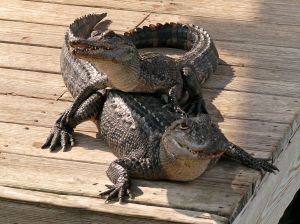Florida alligator facts
 By: Johan
By: Johan 
Florida alligator facts – eyes
The eyes of the Florida alligator are found in the top of the alligator head. This Florida alligator fact is an adaptation to a predominantly aquatic existence. The eyes are large and provide the alligator with superior night vision. During the day when sunlight is abundant, the pupils will close down to no more than a narrow gash. The upper and lower eyelids are well developed, and the eyes are also equipped with nictitating membranes.
Florida alligator facts – breathing
Several interesting Florida alligator facts are linked to the way this animal absorbs oxygen. The Florida alligator breaths through nasal cavities located above the secondary plate. The air is transported to the throat behind a special valve that creates a barrier between the throat and the mouth. Since the Florida alligator has no fleshy lips capable of effectively closing the mouth, this valve is necessary to keep water out of the throat. This fascinating Florida alligator fact makes it possible for the alligator to breathe even when it is almost completely submerged. The Florida alligator can also open its mouth to grab prey under water without getting any water in its throat.
Florida alligator facts – aquatic life
In addition to the fascinating Florida alligator facts described above, the alligators have developed a series of other interesting anatomical features that makes them highly suitable for an aquatic life. They can for instance close their ears as well as their nostrils to prevent water from entering while submerged. Ears and nostrils, as well as the eyes, are located on top of the head in order to work well even when the alligator is almost completely under water. The alligator have 5 forelimbs and 4 hind limbs – all of them webbed. This Florida alligator fact makes the animal a skilled swimmer, especially since it is combined with the force provided by the alligator’s highly muscular and laterally compressed tail. In the Florida alligator, the tail provides force while the limbs function as rudders.
Florida alligator fact – diet
It is a well known Florida alligator fact that this species gladly include a wide range of different preys in their diet. They are capable hunters, but will also scavenge when given the opportunity. They feed on water living creatures, such as fish and crustaceans, as well as on land living mammals. Insects, frogs, snakes and waterfowl are frequently included in the diet of Florida alligators. Adult alligators can even prey on cattle, dogs and other large mammals.
The sharp Florida alligator teeth are never used for chewing, they are only there to seize and hold prey. The strong jaws of the Florida alligator can also crush prey while the teeth are used to hold the animal in position in the mouth. If an animal is too large to swallow, the Florida alligator will not chew it into smaller parts – it will instead rotate the body in a longitudinal spin that serves to dismember the prey and turn it into more manageable portions.
Another interesting Florida alligator fact is how this species ingest and retain non-food items, especially stones. We still do not know for sure why the Florida alligator does this, but biologists suspect that the items might function as ballast and/or aid digestion. This behaviour is known from several other animals. “Stomach stones” are formally known as gastroliths.
Alligator Articles:
Florida Alligator
Florida Alligator Habitat
Florida Alligator Hunting
